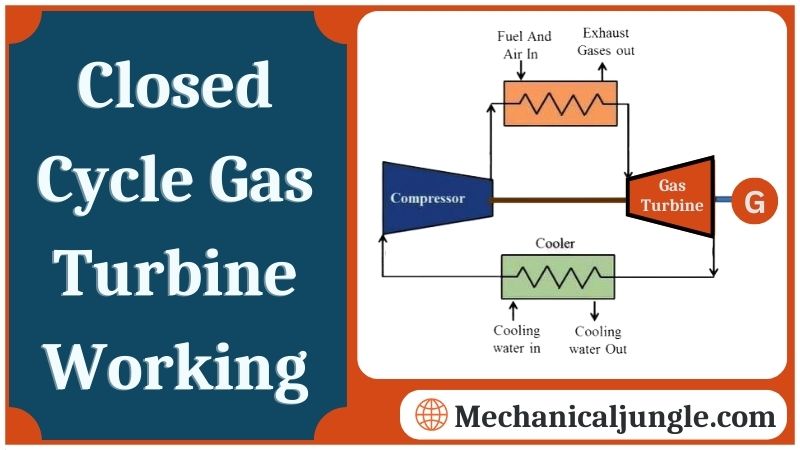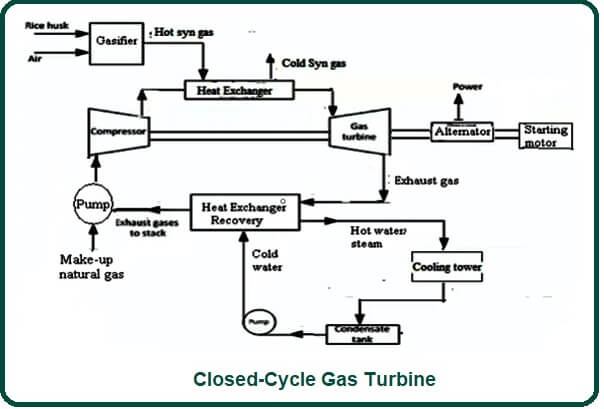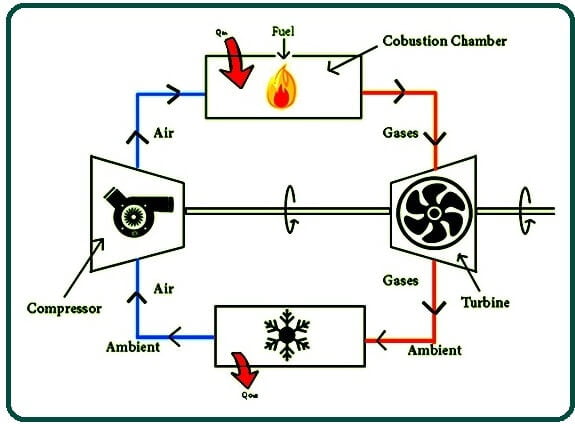
What Is a Closed-Cycle Gas Turbine?

Closed-cycle gas turbines can be defined as gas turbines, which removes the drawbacks of open-cycle gas turbines. In thises type of turbine, the air is continuously circulated within the gas turbine with the help of a compressor, heat chamber, gas turbine, and cooling chamber.
The ratio of pressure, temperature, and air velocity will be constant in this type. It performs a thermodynamic cycle, which means that the fluid is circulated and used continuously without leaving the system.
A closed-cycle gas turbine diagram is very simple and includes components such as a compressor, heat chamber, and gas turbine. The generator, compressor, and cooling chamber are powered by a gas turbine. Its picture is shown below.
- The gas is compressed in the compressor.
- Compressed gas is heated in a heating chamber.
- Gas turbine helps in generating electricity.
- Electricity is generated by the generator using a gas turbine.
- The cooling gases passing from the turbine are cooled in the cooling chamber.
The closed bicycle gas turbine is an extended version of the open cycle gas turbine. Coolers are added to the open cycle gas turbines to make them closed cycle gas turbines.
A closed cycle means that the fluid used in this cycle will be used in a cyclic manner repeatedly and will not be released into the atmosphere. The working fluid in this cycle will be in gaseous form. Commonly used liquids are air, argon, helium, etc.
Working of Closed Cycle Gas Turbine:

#1. Isentropic Compression
Let’s assume air is the working fluid. When the air enters the compressor, the air will be compressed. Due to compression, the pressure & temperature will increase, but the entropies will remain constant.
In the P-V diagram, the pressures (P) will increases from P1 to P2, & the volume will decreases from V1 to V2 due to compression.
In the T-S diagrams, the temperature (T) will increase from T1 to T2, and the entropy will remain constants as it is an isentropic process.
#2. Constant Pressure Heat Addition
From 2 to 3, compressed air from the compressors will enter the burner. In the burner, the external fuel provides in the combustion chamber will mix with air, & the mixture will burn inside the combustion chambers after mixing with each other.
After burning, the temperatures will increase, & the expansion of air will occur at constant pressure. SO in the combustion chamber, constant pressure heat addition will occur.
In the P-V diagrams, the pressure (P) will remain constant, & the volume will increase from V2 to V3.
In the T-S diagram, the temperatures (T) will increase from T2 to T3, and the entropy will also increase from S2 to S3.
#3. Isentropic Expansion
This process will be the opposite of processes 1-2. The heated air from the burners or combustion chambers will reach the turbine, & the air will expand inside the turbine, & some work will be done due to expansion.
This process will be an isentropic process, & no heat will be transferred during this process. In this process, the volume will increase due to expansion, and pressure will decrease.
In the P-V diagram, the volumes (V) will increase from V3 to V4, & pressure (P) will decrease from P3 to P4.
In the T-S diagrams, the temperature (T) will decrease from T3 to T4, and the entropy (S) will remain constant as it is an isentropic process.
#4. Constant Pressure Heat Rejection
This process is the opposite of processes 2-3. In this process, the hot air from the turbine is again cooled and brought to its initial state so that it can be used again.
In the P-V diagram, the pressures (P) will remain constant, & volume (V) will decrease from V4 to V1.
In the T-S diagrams, the temperature (T) will decrease from T4 to T1 due to cooling, and entropy (S) will also decrease from S4 to S1 due to heat rejection.
Components of Closed Cycle Gas Turbine:
#1. Compressor
In the compressors, the isentropic process will be carried out, i.e., the process will be adiabatic & reversible. No heat will be transferred during thises process.
#2. Burner or Combustion Chamber
After passing through the compressor, air will enter the burner or A. Combustion chamber. In this burner, a constant pressure process will occur. The pressure will remain constant, but the temperature will increase as the heat increases, and the volume will also increase.
#3. Turbine
When the hot air from the combustion chambers will reach the turbine and strike the blade of the turbine, the air will expand, & the turbine will rotate. This expansion of air in the turbines will be an asynchronous process.
The turbine is connected to the turbine with a shaft. Both the compressor and the turbine have the same shaft. When the turbine rotates, it also transfers its power to the compressor and helps it to rotate. The turbine also transfers its power to some tributaries.
The turbines are connected to a generator through a coupling. As the turbine rotates, the generator will produce electricity using the work done by the turbine.
#4. Cooler or Pre Cooler
After working in the turbine, the air is sent to the cooler. The cooler will cool the air to return to its original or initial state. The cooling process in the cooler will be carried out under constant pressure.
Working Principle of Closed Cycle Gas Turbine:
The closed-cycle gas turbines working principle is based on the Bretton cycle or the Joule cycle. In this type of gas turbine, a compressor is used to compress the gas isotropically, and the resulting compressed gas flows into the heating chamber. A rotor-type compressor is preferred in this turbine.
An external source is used to heat the compressed air and then passes over the turbine blades. When the gas is flowing over the top of the turbine blade, it expands and is allowed to enter the cooling chamber and cool down.
The gas is cooled using the circulation of water under constant pressure at its initial temperature.
- Again, gas is passed into the compressor, & the process is repeated.
- In these turbines, the same gas is circulated repeatedly.
- The complexity and cost of the system will increase if the fluid/medium used in the turbine is other than air. This can cause problems and is difficult to solve.
Difference Between Open Cycle and Closed Cycle Gas Turbine:
The heat source, the type of fluid used to operate, the circulating air, the capacity of the turbine blades, the cost of maintenance and installation, etc., differentiate between open cycle and closed gas turbines. The main difference is the circulation of the working fluid.
| Open Cycle Gas Turbine | Closed Cycle Gas Turbine |
| In this type, the combustion chamber is used for heating compressed air. Due to the mixing of products in the combustion chamber and heated air, the gas doesn’t remain constant. | In this type, the heating chamber heats compressed air, which is compressed firstly before heating. When an external source heats the air, then the gas remains constant. |
| The amount of gas that came out from the turbine is exhausted in the atmosphere. | The amount of gas came out from the gas turbine is allowed to pass into the cooling chamber. |
| Replacement of working fluid is continues | Circulation of working fluid continues. |
| The working fluid is air. | For better thermodynamics properties, helium is used as a working fluid |
| As the air in the combustion chambers gets contaminated, it results in the earlier wearing of turbine blades. | As there are no contaminations of enclosed gas while passing through the heating chamber, it results in no earlier wearing of turbine blades. |
| They are mainly used for moving vehicles. | Mainly used for stationary installation & marine applications. |
| The cost of maintenance is low | The cost of maintenance is high |
| Installation mass per KW is less | Installation mass per KW is more. |
Advantages of Closed Cycle Gas Turbine:
Closed-cycle gas turbine advantages are
- In a closed-cycle gas turbine, turbine blades erode due to contaminated gases, and dusting leads to fouling of the compressor blades. Therefore the life of the turbine and compressor is extended.
- There is no atmospheric back pressure on the turbine exhaust like an open cycle gas turbine in a closed cycle.
- In a closed-cycle gas turbine, there is no need to filter the air coming into the compressor.
- Working fluid densities can be maintained high by increasing the internal pressure range. Therefore, compressors and turbines are small for their rated output.
- Lower oil or solid fuel can be used because direct heating is done in a closed-cycle gas turbine. These fuels are of very low cost. Therefore the process is more economical.
- It has a high output and efficiency.
- Maintenance costs are low.
Disadvantages of Closed Cycle Gas Turbine:
Closed-cycle gas turbine Disadvantages are
- Due to the high internal pressure in the system, all the components used have complex designs that increase the cost significantly.
- Its response to differential load is worse than that of an open cycle gas turbine.
- It requires very large heat exchangers because, indirectly, the working fluid is heated.
- An additional component pre-cooler is added to the closed cycle gas turbine, which requires a significant amount of cold water.
Applications of Closed Cycle Gas Turbine:
The closed-cycle gas turbine application includes the following.
- They are used in the generation of electric power.
- They are used in many industrial applications.
- They are used in marine propulsion, locomotive propulsions, and automotive propulsion.
- They are used in aviation to provide power to jet Propulsion.
FAQs about Closed-Cycle Gas Turbines:
What Is a Closed-Cycle Gas Turbine?
A closed-cycle gas turbine is a type of turbine where the working fluid, typically air or another gas, remains within the system and is continuously recycled through a series of processes without being released into the atmosphere.
How Does a Closed-Cycle Gas Turbine Differ from an Open-Cycle Gas Turbine?
In a closed-cycle gas turbine, the working fluid circulates within a closed loop, whereas in an open-cycle gas turbine, the working fluid is released into the atmosphere after passing through the turbine.
What Are the Main Components of a Closed-Cycle Gas Turbine?
The main components include a compressor, a heating chamber (or burner), a gas turbine (where expansion occurs), and a cooling chamber (to cool the working fluid back to its initial state).
What Are the Advantages of Using a Closed-Cycle Gas Turbine?
Advantages include extended turbine and compressor life due to cleaner operating conditions, higher efficiency due to constant internal pressure and temperature control, and suitability for diverse applications including power generation and industrial processes.
What Are the Disadvantages of Closed-Cycle Gas Turbines?
Disadvantages include higher initial costs due to complex design and the need for large heat exchangers, reduced responsiveness to variable loads compared to open-cycle turbines, and the requirement for additional components like pre-coolers.
Where Are Closed-Cycle Gas Turbines Commonly Used?
They are used in stationary power generation, industrial applications requiring high efficiency and reliability, marine propulsion systems, and certain types of automotive and aviation applications.
How Does the Operation of a Closed-Cycle Gas Turbine Contribute to Energy Efficiency?
By maintaining a closed loop for the working fluid, these turbines can operate at higher internal pressures and temperatures, which enhances thermodynamic efficiency and reduces the need for external heat input.
What Are the Environmental Benefits of Closed-Cycle Gas Turbines?
Closed-cycle turbines produce lower emissions compared to open-cycle turbines since the working fluid remains contained and does not mix with atmospheric air during operation, thereby reducing pollution.
What Role Do Heat Exchangers Play in Closed-Cycle Gas Turbines?
Heat exchangers are crucial for maintaining the temperature of the working fluid. They facilitate the transfer of heat into and out of the system, ensuring efficient operation by cooling the fluid after expansion and heating it before compression.
How Do Closed-Cycle Gas Turbines Contribute to Sustainable Energy Practices?
By optimizing energy conversion processes and reducing emissions, closed-cycle gas turbines support sustainable energy practices by providing efficient and reliable power generation solutions across various industries.

